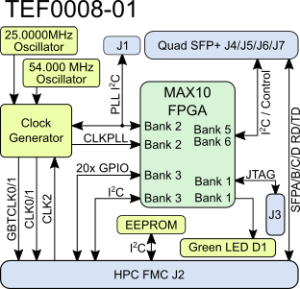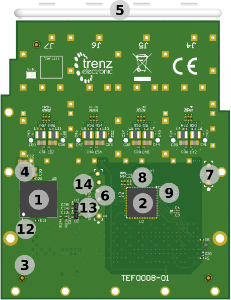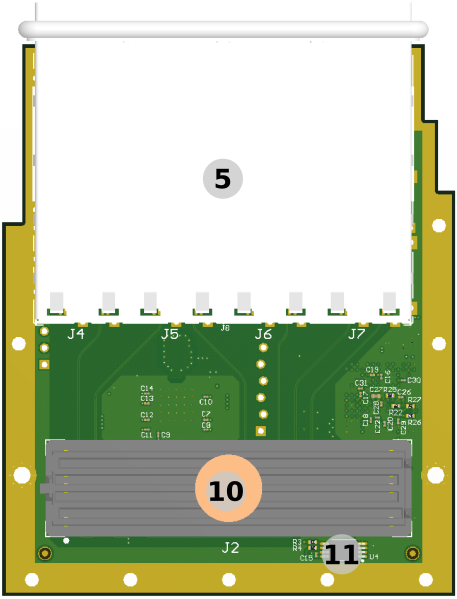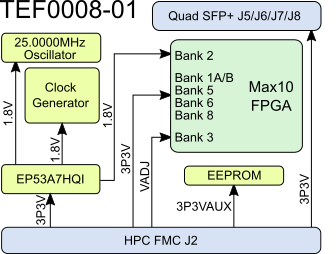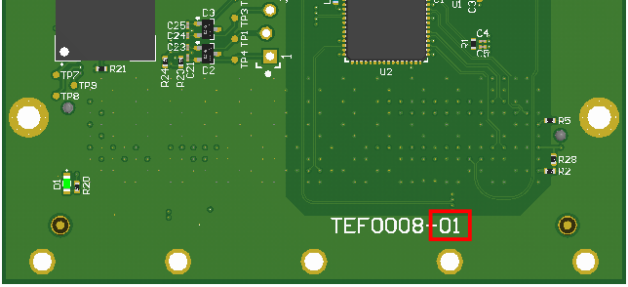Page History
...
Block Diagram
Figure 1: TEF0008 -01 block diagram.
Main Components
Figure 2: TEF0008 -01 FMC overview.
Table 1: TEF0008 -01 main components.
- MAX10 FPGA, U5
- Programmable low jitter clock generator Si5354A, U2
- Status LED (green), D1
- 3.3V to 1.8V DCDC converter, U6
- Quad SFP+ cage and connectors, J4-J7
- 1x6 pin header for JTAG programming of FPGA (3.3V), J3
- 1x3 pin header for I²C (1.8V), J1
- XTAL 54.0000 MHz (CX3225SB), Y1
- Oszillator 25.000000 MHz (SiT8008B), U1
- HPC FMC connector, J2
- 128KBit EEPROM, U4
- Testpoints Max10, TP7-TP9
- Testpoints JTAG, TP1-TP4
- Testpoints Power, TP5, TP6, TP10
...
Table 7: I2C slave device addresses.
On-board Peripherals
| HTML |
|---|
<!--
Components on the Module, like Flash, PLL, PHY...
--> |
MAX10 FPGA
The MAX10 FPGA (10M08SAU169C8G) is used as SFP control, level shifter and I2C MUX. For a detailed description see TEF0008 MAX10.
Programmable Clock Generator
There is a Silicon Labs I2C programmable clock generator on-board (Si5345A, U2) to generate reference clocks for the module. Programming can be done using I2C via PIN header J1. The I2C bus is also routed to the MAX10 FPGA.
...
IN0
...
Reference input clock.
...
IN2
...
-
...
IN3
...
A1
...
-
...
OUT0
...
CLKPLL2F
...
FPGA bank 2.
...
-
...
Not connected.
...
Output
...
Table 8: Programmable clock generator inputs and outputs.
Oscillators
The module has following reference clock signals provided by on-board oscillators and external source from carrier board:
...
Table 9: Reference clock signals.
EEPROM
A Microchip 24LC128-I/LC serial EEPROM (U4) is provided for IPMI data. It is accessible via the LPC FMC connector (SCL C30, SDA C31).
On-board LED
...
HPC FMC Connector
The following table lists all on the FMC connector assigned net names.
| A | B | C | D | E | F | G | H | J | K | |
|---|---|---|---|---|---|---|---|---|---|---|
| 1 | GND | NetJ2_B1 | GND | PG_C2M | GND | PG_M2C | GND | GND | ||
| 2 | SFPB_RD_P | GND | SFPA_TD_P | GND | GND | CLK1_P | GND | GND | ||
| 3 | SFPB_RD_N | GND | SFPA_TD_N | GND | GND | CLK1_N | GND | GND | ||
| 4 | GND | GND | GBTCLK0_P | GND | GND | CLK0_P | GND | CLK2_P | ||
| 5 | GND | GND | GBTCLK0_N | GND | GND | CLK0_N | GND | CLK2_N | ||
| 6 | SFPC_RD_P | GND | SFPA_RD_P | GND | GND | LA00_P | GND | GND | ||
| 7 | SFPC_RD_N | GND | SFPA_RD_N | GND | LA00_N | LA02_P | ||||
| 8 | GND | GND | LA01_P | GND | GND | LA02_N | GND | |||
| 9 | GND | GND | LA01_N | GND | LA03_P | GND | GND | |||
| 10 | SFPD_RD_P | GND | LA06_P | GND | LA03_N | LA04_P | ||||
| 11 | SFPD_RD_N | GND | LA06_N | LA05_P | GND | GND | LA04_N | GND | ||
| 12 | GND | GND | LA05_N | GND | LA08_P | GND | GND | |||
| 13 | GND | GND | GND | LA08_N | LA07_P | |||||
| 14 | GND | LA09_P | GND | GND | LA07_N | GND | ||||
| 15 | GND | LA09_N | GND | GND | GND | |||||
| 16 | GND | GND | GND | |||||||
| 17 | GND | GND | GND | GND | GND | |||||
| 18 | GND | GND | GND | GND | ||||||
| 19 | GND | GND | ||||||||
| 20 | GND | GBTCLK1_P | GND | GND | GND | GND | ||||
| 21 | GND | GBTCLK1_N | GND | GND | GND | GND | ||||
| 22 | SFPB_TD_P | GND | GND | |||||||
| 23 | SFPB_TD_N | GND | GND | GND | GND | |||||
| 24 | GND | GND | GND | GND | GND | |||||
| 25 | GND | GND | GND | |||||||
| 26 | SFPC_TD_P | GND | GND | GND | GND | |||||
| 27 | SFPC_TD_N | GND | GND | GND | GND | |||||
| 28 | GND | GND | GND | |||||||
| 29 | GND | GND | TCK | GND | GND | GND | ||||
| 30 | SFPD_TD_P | GND | FMC_SCL | TDI | GND | GND | GND | |||
| 31 | SFPD_TD_N | GND | FMC_SDA | TDO | ||||||
| 32 | GND | GND | 3P3VAUX | GND | GND | GND | ||||
| 33 | GND | GND | TMS | GND | GND | GND | ||||
| 34 | GND | GA0 | ||||||||
| 35 | GND | 12V | GA1 | GND | GND | GND | ||||
| 36 | GND | GND | 3P3V | GND | GND | GND | ||||
| 37 | GND | 12V | GND | |||||||
| 38 | GND | GND | 3P3V | GND | GND | GND | ||||
| 39 | GND | 3P3V | GND | VADJ | GND | VADJ | GND | GND | ||
| 40 | GND | GND | 3P3V | GND | VADJ | GND | VADJ | GND |
Table 8: HPC FMC Connector pin assignment.
On-board Peripherals
| HTML |
|---|
<!--
Components on the Module, like Flash, PLL, PHY...
--> |
MAX10 FPGA
The MAX10 FPGA (10M08SAU169C8G) is used as SFP control, level shifter and I2C MUX. For a detailed description see TEF0008 MAX10.
Programmable Clock Generator
There is a Silicon Labs I2C programmable clock generator on-board (Si5345A, U2) to generate reference clocks for the module. Programming can be done using I2C via PIN header J1. The I2C bus is also routed to the MAX10 FPGA.
| Si5345A Pin | Signal Name / Description | Connected To | Direction | Note | Default |
|---|---|---|---|---|---|
IN0 | Reference input clock. | U1 | Input | 25.000000 MHz oscillator, Si8208AI | |
| IN1 | - | Not connected. | Input | Not used. | |
IN2 | - | Not connected. | Input | Not used. | |
IN3 | CLK2 | J2-K4/K5 | Input | HPC FMC configured as C2M clock. | |
A1 | - | GND | Input | I2C slave device address LSB. | |
| XAXB | - | Y1 | Input | 54.0000 MHz XTAL CX3225SB | |
OUT0 | CLKPLL2F | U5-H6/G5 | Output | FPGA bank 2. | 25MHz |
| OUT1 | - | Not connected. | Output | Not used. | --- |
| OUT2 | GBTCLK1 | J2-B20/B21 | Output | M2C via HPC FMC. | 125MHz |
| OUT3 | - | Not connected. | Output | Not used. | --- |
| OUT4 | - | Not connected. | Output | Not used. | --- |
| OUT5 | - | Not connected. | Output | Not used. | --- |
| OUT6 | - | Not connected. | Output | Not used. | --- |
| OUT7 | GBTCLK0 | J2-D4/D5 | Output | M2C via HPC FMC. | 156.25MHz |
| OUT8 | CLK0 | J2-H4/H5 | Output | M2C via HPC FMC. | 156.25MHz |
| OUT9 | CLK1 | J2-G2/G3 | Output | M2C via HPC FMC. | 125MHz |
Table 9: Programmable clock generator inputs and outputs.
Oscillators
The module has following reference clock signals provided by on-board oscillators and external source from carrier board:
| Clock Source | Schematic Name | Frequency | Clock Destination |
|---|---|---|---|
| SiTime SiT8008AI oscillator, U1 | - | 25.000000 MHz | U2-63/64 |
| Carrier board via HPC FMC J2-K4/K5 | CLK2 | Defined by carrier. | U2-61/62 |
Table 10: Reference clock signals.
EEPROM
A Microchip 24LC128-I/LC serial EEPROM (U4) is provided for IPMI data. It is accessible via the LPC FMC connector (SCL C30, SDA C31).
On-board LED
| LED | Color | Connected to | Description and Notes |
|---|---|---|---|
| D1 | Green | U5-C2 (bank 1A) | Depending on FPGA design. With the shipped FPGA design it is on, if at least one SFP is connected. |
Table 11: On-board LED.
Power and Power-On Sequence
| HTML |
|---|
<!--
If power sequencing and distribution is not so much, you can join both sub sections together
--> |
Power Consumption
The maximum power consumption of a module depends on the design running on the FPGA.
| 3P3V | TBD* |
| VADJ (at 1.8V) | TBD* |
3P3VAUX | TBD* |
Table 12: Typical power consumption.
* TBD - To Be Determined with reference design setup.
Power Distribution Dependencies
Figure 3: Module power distribution diagram.
Power Rails
Power Rail Name | HPC FMC Connector (J2) | Direction | Notes |
|---|---|---|---|
| 3P3V | D36, D38, D40, C39 | Input | Supply voltage from carrier board. |
| 1.8V | - | Output | Module on-board 1.8V voltage supply (Max 1A). |
3P3VAUX | D32 | Input | Supply voltage from carrier board. |
VADJ | H40, G39, F40, E39 | Input | Supply voltage from carrier board. |
| 12V | C35, C37 | Input | Not used supply voltage from carrier board. |
Table 13: Module power rails.
Bank Voltages
Bank | Schematic Name | Voltage | Voltage Range |
|---|---|---|---|
| 1A | 3P3V | 3.3V | - |
| 1B | 3P3V | 3.3V | - |
| 2 | 1.8V | 1.8V | - |
| 3 | VADJ | Carrier supplied | 1.2V - 3.3V |
| 5 | 3P3V | 3.3V | - |
| 6 | 3P3V | 3.3V | - |
| 8 | 3P3V | 3.3V | - |
Table 14: Module PL I/O bank voltages.
Variants Currently In Production
| Module Variant | FPGA | Operating Temperature | Temperature Range |
|---|---|---|---|
| TE0008-02 | 10M08SAU169C8G | 0°C to +85°C | Extended |
Table 15: Module variants.
Technical Specifications
Absolute Maximum Ratings
Parameter | Min | Max | Units | Reference Document |
|---|---|---|---|---|
Storage temperature | -40 | 85 | °C | - |
Table 16: Module absolute maximum ratings.
Operating Temperature Ranges
Extended grade: 0°C to +85°C.
Physical Dimensions
Module size: 69 mm × 84 mm, SFP+ conector excluded (+ 5.5 mm). See Vita 57.1 standard.
PCB thickness: 1.6 mm.
Highest part on PCB top is 9.5 mm (SFP+ cage, excluded front plate), bottom 1.4 mm (MAX10 FPGA). Please download the step model for exact numbers.
All dimensions are given in millimeters.
Figure 4: Module physical dimensions drawing
| Note |
|---|
Mounting holes near the front pannel are not implemented due to physical restrictions caused by the SFP cage. The dimensions exceed in some area the by Vita 57.1 standard defined dimensions. In the middle region of the card the cage is higher than the specified max high for this area. Check carefully if the carrier card uses this space for other components conflicting mechanical. The bottom side is at the high limit. |
Revision History
Hardware Revision History
| Date | Revision | Notes | PCN | Documentation Link |
|---|---|---|---|---|
| 2018-06-06 | 02 | First production release | ||
| - | 01 | Prototypes |
Table 17: Module hardware revision history.
Hardware revision number can be found on the PCB board together with the module model number separated by the dash.
Figure 5: Module hardware revision number.
Document Change History
| HTML |
|---|
<!--
Generate new entry:
1.add new row below first
2.Copy "Page Information Macro(date)" Macro-Preview, Metadata Version number, Author Name and description to the empty row. Important Revision number must be the same as the Wiki document revision number
3.Update Metadata = "Page Information Macro (current-version)" Preview+1 and add Author and change description.
--> |
Date | Revision | Contributors | Description | ||||||||||||||||||||||||||
|---|---|---|---|---|---|---|---|---|---|---|---|---|---|---|---|---|---|---|---|---|---|---|---|---|---|---|---|---|---|
|
|
|
| ||||||||||||||||||||||||||
| 2018-08-24 | v.38 | Martin Rohrmüller |
| ||||||||||||||||||||||||||
2018-06-15 | Martin Rohrmüller |
| |||||||||||||||||||||||||||
| --- | all |
|
|
Table 18
Table 10: On-board LED.
Power and Power-On Sequence
| HTML |
|---|
<!--
If power sequencing and distribution is not so much, you can join both sub sections together
--> |
Power Consumption
The maximum power consumption of a module depends on the design running on the FPGA.
...
3P3VAUX
...
TBD*
Table 11: Typical power consumption.
* TBD - To Be Determined with reference design setup.
Power Distribution Dependencies
Figure 3: Module power distribution diagram.
Power Rails
...
Power Rail Name
...
HPC FMC Connector (J2)
...
Direction
...
3P3VAUX
...
VADJ
...
Table 12: Module power rails.
Bank Voltages
...
Bank
...
Voltage
...
Voltage Range
...
3.3V
...
Table 13: Module PL I/O bank voltages.
Variants Currently In Production
...
Operating Temperature
...
Table 14: Module variants.
Technical Specifications
Absolute Maximum Ratings
...
Parameter
...
Units
...
Reference Document
...
Storage temperature
...
-40
...
°C
...
Table 15: Module absolute maximum ratings.
Operating Temperature Ranges
Extended grade: 0°C to +85°C.
Physical Dimensions
Module size: 69 mm × 84 mm, SFP+ conector excluded (+ 5.5 mm). See Vita 57.1 standard.
PCB thickness: 1.6 mm.
Highest part on PCB top is 9.5 mm (SFP+ cage, excluded front plate), bottom 1.4 mm (MAX10 FPGA). Please download the step model for exact numbers.
All dimensions are given in millimeters.
Figure 4: Module physical dimensions drawing
| Note |
|---|
Mounting holes near the front pannel are not implemented due to physical restrictions caused by the SFP cage. The dimensions exceed in some area the by Vita 57.1 standard defined dimensions. In the middle region of the card the cage is higher than the specified max high for this area. Check carefully if the carrier card uses this space for other components conflicting mechanical. The bottom side is at the high limit. |
Revision History
Hardware Revision History
...
Notes
...
01
Table 16: Module hardware revision history.
Hardware revision number can be found on the PCB board together with the module model number separated by the dash.
Figure 5: Module hardware revision number.
Document Change History
| HTML |
|---|
<!--
Generate new entry:
1.add new row below first
2.Copy "Page Information Macro(date)" Macro-Preview, Metadata Version number, Author Name and description to the empty row. Important Revision number must be the same as the Wiki document revision number
3.Update Metadata = "Page Information Macro (current-version)" Preview+1 and add Author and change description.
--> |
...
Date
...
Revision
...
Contributors
...
Description
...
Martin Rohrmüller
...
Initial document.
...
all
...
Jan Kumann, John Hartfiel
Table 17: Document change history.
...
